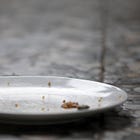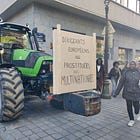Another Summer of Fires
Of both the literal and metaphorical kind
It’s only been three weeks since my last Thin Ink but so much has happened that I’m still catching up on the news. So I thought some of you might be in the same boat and a quick round-up might be useful.
I’ve intentionally kept this week’s issue brief-ish while going all out on Thin’s Pickings. This is partly due to friends’ useful feedback: that my newsletter is sometimes too long and bleak, but they really enjoy the recommendations. Partly due to me reading a fair bit during the break.
The feedback is also why I’m including a good news section which I hope will become a more regular thing.
Those conversations also made me realise I’m long overdue to do a reader survey to make sure Thin Ink is still interesting and useful to you. I hope to come up with a pithy questionnaire before the end of the year. If you have any tips, I’m all ears.

It’s getting hot in here
If you live anywhere north of the equator, you likely experienced or know someone who experienced at least one heatwave this summer.
June 2025 was the third warmest June on record globally, resulting in two major heatwaves in western Europe and the Mediterranean, with temperatures in parts of Portugal feeling like 48°C and Spain and the UK reporting highest temperatures for June since 1961 and 1884 respectively, according to the EU’s Copernicus Climate Change Service.
July 2025 received the same dubious accolade, with heatwaves hitting southern and eastern Europe this time. Nordic countries, normally known for their cool climates, also experienced an intense heatwave that scientists say was made more likely due to climate change.
But it’s not just Europe. In June, a large part of the United States, northern Canada and central Asia saw “warmer-than-average temperatures” while record-breaking warmth was reported in Japan (which threatens the rice production), some regions of China, and many Korean cities, said Copernicus.
The more unfortunate residents experienced the terrible wildfires that raged in many countries, including Cyprus, Greece, Croatia, Spain, Portugal, Türkiye, France, the UK, the U.S., and Brazil.
These conditions led to about 1,500 - 2,300 estimated heat-related deaths across 12 major European cities and displaced nearly 100,000 in Europe alone, according to Nature.
In Japan, thousands of people were hospitalised with heat-related illnesses in the last two weeks of July. In Korea, over 2,000 heat-related illnesses were recorded between May 20 and July 26, the highest since the Korea Disease Control and Prevention Agency began compiling data in 2011.
Yet we continue to burn things
It’s been over three years since Bill McKibben wrote this New Yorker piece: “In a world of fire, stop burning things”. Of course, it was about our addiction to fossil fuels but I feel it’s also an apt description of our failure to put out the metaphorical fires.
Let’s start with the unimaginable devastation of food systems and journalism in Gaza.
🍽️ 🆘 Famine has been officially declared in Gaza. “Over half a million people in the Gaza Strip are facing catastrophic conditions characterised by starvation, destitution and death”, said the latest IPC report published today.
If you’re unsure of what that means, famine is the most extreme category of hunger that is triggered only when three critical thresholds are breached:
extreme food deprivation,
acute malnutrition,
starvation-related deaths.
Famine conditions are projected to spread from Gaza Governorate to Deir Al Balah and Khan Younis Governorates in the coming weeks. These are the results of using starvation as a deliberate strategy.
🚜🌾👨🌾 Only 1.5% of cropland in the Gaza Strip is accessible and undamaged, according a recent assessment by the U.N. food and agriculture agency (FAO). That is a shockingly low number.
The assessment added that 86% of total cropland, amounting to nearly 13,000 hectares, is damaged while all cropland in Rafah, North Gaza and nearly all cropland in the Gaza governorate are not accessible.
What this means is that the vast majority of Gazans must now rely on food aid, but the food distribution sites run by the Israel- and US-backed Gaza Humanitarian Foundation (GHF) are places of “orchestrated killing and dehumanisation” and not aid, international medical charity MSF said in a scathing new report.
At the same time, the few journalists who are documenting these horrors on the ground are being systemically killed by the Israeli State. Case in point: the deliberate targeting of Al-Jazeera journalists on Aug 11.
Yet the world continues to do little beyond wringing our collective hands and sending thoughts and prayers. Worse, international aid agencies held a secret collaboration with the GHF on Aug 8, The New Humanitarian reported.
🥤🗑️ Another extremely disappointing outcome of multilateralism this summer was the collapse of the plastic treaty talks, which ended without an agreement. Once again, a handful of fossil-fuel-producing countries - the Gulf States, Russia, the U.S., et al - held the discussions, and the world, hostage. In case anyone needs reminding, most plastics are derived from petroleum and natural gas.
Despite mounting evidence of how plastic pollution is poisoning ecosystems and our bodies, the talks - known under the decidedly unappealing technical acronym INC-5.2 - made little substantial headway and ended abruptly and haphazardly, according to attendees and observers.
If you want a blow-by-blow account of what happened, IISD has a great summary as well as daily reports. Just be warned that they make for depressing reading.
I find the lack of action both mind boggling and offensive, given the summer we’re having and mounting evidence that climate-induced drought and heat can cause spilled over effects that go far beyond physical discomfort.
♨️ For example, a 12-month drought is associated with an estimated 7% increase in the risk of intimate partner violence against women, according to a new paper in JAMA Network that used global survey data for nearly half a million women.
The study, with data from 42 low- and middle-income countries in Africa, Asia, Latin America and the Caribbean, found “a positive and consistent association” with different types of violence - emotional, physical, and sexual - and higher temperatures.
🥤🥗🍔🍗🍟🥓 I’d like to close this section on a slightly lighter note by sharing this YouGov piece on foods that Americans hate or dislike. Topping the list was anchovies, followed by liver, sardines, tofu, and squid. Sushi, beets and kale also made appearances in the top 10.
Perhaps new data showing that ultraprocessed foods make up 55% of Americans’ diet (62% for those under 18) explains the list. I mean, why else would delicious and flavourful foods be in that list unless it’s because Americans have become too used to foods that are “hyperpalatable, energy-dense, low in dietary fiber, and contain little or no whole foods, while having high amounts of salt, sweeteners, and unhealthy fats”?
I doubt there’ll be any substantial improvements in the near future. Despite all the bluster from the Make America Healthy Again (MAHA) movement, a leaked copy of the White House’s “highly anticipated... report on the health of American children” showed there won’t be direct restrictions on ultraprocessed foods or pesticides.

But… we can fix it
Restoring 50% of degraded land, reducing food waste by 75% and integrating land and marine food systems (say, by replacing 70% of unsustainably produced red meat with sustainably sourced seafood) could slash greenhouse gas emissions, improve biodiversity, and spare an area the size of Africa from becoming degraded and converted into farmland, said 21 scientists. The paper is behind a paywall (GRRR infinity) so you’ll have to rely on the PR here.
Brazil came off the UN Hunger Map after lifting over 40 million people out of food insecurity in just two years. IPES-Food credited the outcome to Luiz Inácio Lula da Silva’s policies enacted after he returned to power in 2023. These include a universal school feeding programme, public procurement from family farmers, and expanding access to affordable food in urban areas. Having seen the good work that community kitchens have been doing in Brasilia, I say bravo!
The 10 winners of the Equator Prize 2025 are an inspirational bunch, from a women-led initiative supporting 5,000 farmers in India to an indigenous-led agrobiodiversity zone that’s the first to be officially recognised in Peru. They also remind us of the good work that’s happening on the ground, despite the omnishambles at the multilateral level.
Green REV Institute, a Polish environmental think tank, filed a complaint with the European Ombudsman, Teresa Anjinho, against the European Commission, for the latter’s failure to adopt a Sustainable Food Systems Law, a key part of the gone-but-not-forgotten Farm to Fork Strategy. It’s possible the complaint will not go far but hey, we gotta start somewhere. For background, I’ve written about the Commission backtracking on sustainable farming commitments here and here.
A federal court ruled in mid-August that the US agricultural department acted wrongfully in cutting funding to farmer and community organisations, including to Agroecology Commons and the Institute of Agriculture and Trade Policy. The terminations, which came while the contracts were already underway and under DOGE’s pressure, were “arbitrary and capricious”, the plaintiffs argued.
This LinkedIn post on the plastic treaty talks by Panama’s special representative on climate change makes me hopeful. Respect.
Thin’s Pickings - Podcast Edition
Good episode untangling all the confusing advice around nutrition, with a side dish of UPF. Sadly, Kevin Hall, whose work was cited as “gold standard” in the episode, left the NIH four months ago, citing censorship.
Big Food, Big Power - The Food Programme
A look into the food industry’s influence when it comes to the British government’s decisions on public health. It featured the experiences of youth activists from BiteBack2030, investigative reporting from The BMJ, and the Soil Association’s attempt to uncover lobbying.
Who is journalism for? - Backlight
Thought provoking episode from my colleague at Lighthouse Reports, discussing how to ensure our work truly serves the public.
Thin’s Pickings - ANH edition
A few issues ago, I wrote about ANH 2025, a biennial gathering of researchers working on the nexus of agriculture, nutrition, and health. Some of the key sessions are now online. Here are three I recommend.
ANH2025 Plenary Keynote: From plantations to petrochemical plants
ANH2025 Panel Discussion: Increasing Demand for Nutritious Diets in Unhealthy Food Environments
Thin’s Pickings - Newsletter Edition
What Andor Can Teach Us About the Food Sovereignty Movement - Offshoot
Great longread from A Growing Culture that combines one of the best shows on TV right now - and I’m not even a Star Wars geek! - with the grassroots food movements. Contains spoilers though, so keep it on file if you haven’t watched the second season.
How Bread vs. Rice Molded History - Uncharted Territories
Fascinating piece on how the climate determined where these two staple crops could grow, and how their different characteristics may have given birth to politically, culturally, and economically different societies.
Going Hungary - Not Drinking Poison
Not easy to pair what seems like a first-world product - natural wines - with illiberalism but Aaron Ayscough is a good writer and he managed to find the right balance.
As always, please feel free to share this post and send tips and thoughts on bluesky @thinink.bsky.social, mastodon @ThinInk@journa.host, my LinkedIn page, twitter @thinink, or via e-mail thin@thin-ink.net.







